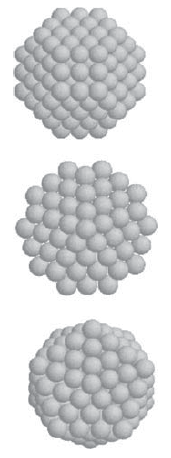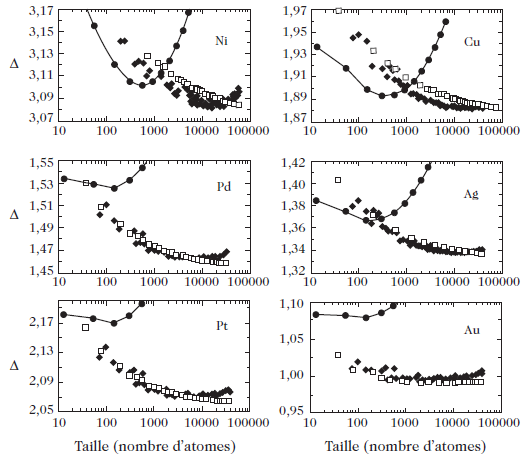
Equilibrium Shape of Nanometric Crystals
 المؤلف:
C. Br´ echignac P. Houdy M. Lahmani
المؤلف:
C. Br´ echignac P. Houdy M. Lahmani
 المصدر:
Nanomaterials and Nanochemistry
المصدر:
Nanomaterials and Nanochemistry
 الجزء والصفحة:
p10
الجزء والصفحة:
p10
 3-2-2016
3-2-2016
 1785
1785
Equilibrium Shape of Nanometric Crystals
The Wulff theorem can be rigorously proven for a macroscopic crystal. But what happens for a nanometric crystal? From the theoretical point of view, this problem can be handled using numerical simulation. As we have seen, we now possess realistic interatomic potentials for most metals. Molecular dynamics can then be used to seek the shape corresponding to minimal energy for constructions of different sizes. Many calculations of this kind have been carried out over the past few years . Figure 1 shows the four main shapes that arise for fcc metals, namely, the truncated octahedron, the cubo-octahedron, the icosahedron, and the truncated decahedron (also known as the Marks decahedron).
These calculations show that for very small sizes the icosahedron is the most stable shape. This result is easy to understand, because it is the most compact shape: it maximises the binding energy by having a shape very close to spherical and it exposes only facets which have the lowest surface energy. However, this structure is not a crystal structure. It cannot therefore extend to macroscopic crystals. In an icosahedron, the central atoms are subject to a very high degree of compression, whilst the surface atoms are relaxed.
If an icosahedron is made to grow, the energy related to these stresses becomes too large compared with the gain in compactness and the structure tends to the normal one, i.e., fcc in this case. Figure 2 shows the stability diagrams of copper, silver, gold, nickel, palladium and platinum clusters up to 50,000 atoms .
It can be seen that, beyond a certain size, the equilibrium shape changes from an icosahedron to a truncated octahedron. The cubo-octahedron (not shown in Fig. 2) is always less stable than the truncated octahedron for a metal with fcc structure. Note, however, that there is an intermediate structure, the truncated decahedron, which is slightly more stable than the truncated octahedron over a certain size range. It is remarkable that the transition from the non-crystalline structure (icosahedron, truncated decahedron) to the fcc structure occurs at very different sizes depending on the metal: below 200 atoms for gold and around 30,000 atoms for copper. Note also that the calculated sizes correspond to closed shell polyhedra, i.e., with no vacancies or adatoms at the surface. These closed shells are obtained for very precise numbers of atoms called magic numbers (see Table 1.1). The magic numbers correspond to clusters with higher stability than clusters with a neighbouring number of atoms.

Fig. 1. Morphology of nanoparticles. (a) Truncated octahedron with 201 atoms.
(b) Cubo-octahedron with 147 atoms. (c) Icosahedron with 147 atoms. (d) Truncated
decahedron with 146 atoms
Table 1.1. Magic numbers for different clusters: icosahedron, cubo-octahedron, truncated (Marks) decahedron, and truncated octahedron (Wulff polyhedron for an fcc crystal)


Fig. 2. Stability of different structures of Cu, Ag, Au, Ni, Pd and Pt clusters as a function of the number of atoms N . Black circle: icosahedron. Black diamond: truncated decahedron. White square: truncated octahedron. Calculations made using molecular dynamics simulations with an N-body potential.
 الاكثر قراءة في كيمياء النانو
الاكثر قراءة في كيمياء النانو
 اخر الاخبار
اخر الاخبار
اخبار العتبة العباسية المقدسة


